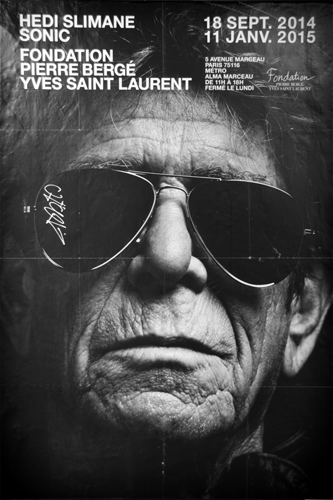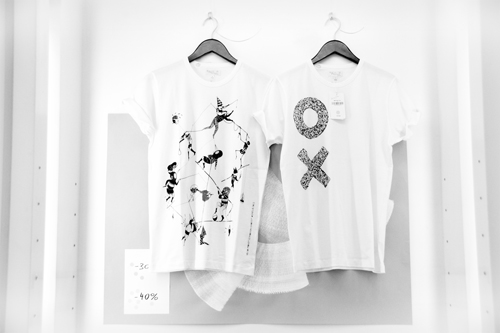
“Mama’s got a lover,” sang Lou Reed, in a track by that name from his 1986 album Mistrial,
A painter I am told
She’s getting out of real estate
For the art scene down in old Soho
Art scene down in old SohoMama’s got a lover
He owns a gallery
she says he likes collages but
the money’s in graffiti
Money’s in graffiti
The cover of a much earlier album, The Velvet Underground & Nico, issued in 1967 by Verve Records, featured the famous banana print—a peel-off sticker—by Warhol, who made the two-ply image specifically for the record, which he also produced. While the band and The Andy Warhol Foundation for the Arts recently concluded a copyright and trademark dispute over rights to the iconic graphic—the latter had licensed the design to InCase, for use on iPhone and iPad cases—the motif had begged ab ovo to be copied ad nauseam. Red hot yellow readymade fad. Case in point: in 1981, in the 14th arrondissement, a neophyte Blek Le Rat, only twenty at the time (and assisted by his friend Gérard), would lay down one of his very first stencil trials, the VU / Warhol banana on a laddered color field. Arguably the most well-known French street artist and among the first to make graff in Paris that privileged style and startling imagery over expressly political messaging, Blek had stolen chalk from the blackboards at school and loved to walk and chalk, aimlessly tracing undulant waves of calcium carbonate in his wake, like someone losing the sweater off his back as a single white thread, caught on a splinter, unravels. He discovered full-blown rainbow burners in New York in the early 70s, in the subways and out on the ball courts, before amplifying his own habit at home, augmenting the fulsome rat population by stenciling their shadows on walls for over a year. It was another two years before someone called TNT began stenciling bats—then all of a sudden: a movement. Blek took his street name because one, rats are the only wild animals in cities, and two, as he explained to King Adz in an interview, “only rats will survive after the great disaster.” Early on it was hard to find spray cans in Paris. Best bet, he said, were the shoe stores.

XOXO: the universal code, when closing a letter, for kisses and hugs. Every episode of Gossip Girl ends on the phrase. Seen from above, the O depicts two lovers embracing, the X their mouths interlocked. It’s also thought that in the Middle Ages, illiterate Christians may have signed their name X, while Jews unable to write wrote O. At the same time, the one letter is open, as rounded for flow as the other interdicts; together they send a mixed signal: love me, love me not. Although they look like they’d have to be, on account of their obsessive detail, the designs by ubiquitous street artist Le MoDuLe De ZeeR are not pre-fabbed in a studio and applied to outdoor spaces after. Instead, his trademark Xs and Os are a one-shot piece of elbow grease: they take a steady hand. In drawing the elaborate, labyrinthine interiors to his otherwise basic forms, he never picks up his pen. His rudimentary letters are little brothers to the single Steadicam take that Alexander Sokurov pulled off in his ravishing film Russian Ark. Whereas the 2002 movie condenses three-hundred years of Saint Petersburg’s history into a magisterial 96-minute sweep, however, De ZeeR’s graphics are pared down and utterly contextless, orphaned from the alphabet—lonely consonant, widowed vowel—as though the surfaces of Paris were playing an eternal, interminable game of Tic Tac Toe: the whole point is to keep on playing. A slip or hiccup means starting over from scratch, but Le MoDuLe De ZeeR has engineered his career with the same seamless assurance caressing his binary bots. Last summer I bumped into his logo draped from a hanger in an upscale fashion boutique. Like all the other stores on opening day of Les Soldes, Agnès b. Homme had put everything on sale. As it was pouring out, on the street one had the impression the sales were a flop, since no one wanted to be caught in the weather. On the other hand, the heavy rain had forced everyone inside, so the shops were more crowded than ever, which is saying a lot. The latest in a series of clothes designed by artists exclusively for Agnès b., the white cotton De ZeeR t-shirt, regularly 70€, was discounted 40%. (Since 1984, Agnès b. has maintained a “galerie du jour” that regularly features street art. As part of a Red Cross benefit, De ZeeR had done a live session last year at the gallery’s current location on la rue Quincampoix in the Marais.) While still too pricey, I guess 42€ would be a more reasonable purchase than Chanel’s graffiti-print backpack, declared a few days later by the New York Post as “the ‘It’ bag of the summer.” At $3,800, the accessory proved a seasonal favorite with Miley Cyrus, Kristen Stewart, and Khloé Kardashian. To go with your gear, you can find Escada Sexy Graffiti perfume for sixty bucks at Macy’s, although Chanel has its own line of pop art eau de toilette.

Wandering the sales without that kind of cash, which I'd blown on a chintzy umbrella, I neither read nor wrote, let alone photographed any bathroom graffiti in the rue de Sèvres chain known as Bathroom Graffiti. To begin with, the store had no bathroom. Looking ahead half a year, to last month: unveiled for Paris Fashion Week, the fall ’15 Junya Watanabe collection features svelte, androgynous runway models—one part Girl with the Dragon Tattoo, one part Indochine, one part Lewis Carroll’s terrible Queen—in starkly monochromatic chiffon, honeycomb waffles, oversize ruffs, studded flats and origami crape. Exposed beneath the accordions and mesh, the women’s calves and ankles, knuckles and wrists have been inked with scribbles, doodles, veins, chicken scratch from the coach’s book, quick and diagrammatic magic-marker autographs. Like their lustrous bodies were cast in plaster, to heal—or hide—the heart.
[With thanks to Nancy Butler.]
Andrew Zawacki is the author of five books of poetry: Unsun : f/11 (2019), Videotape (2013), Petals ...
Read Full Biography

